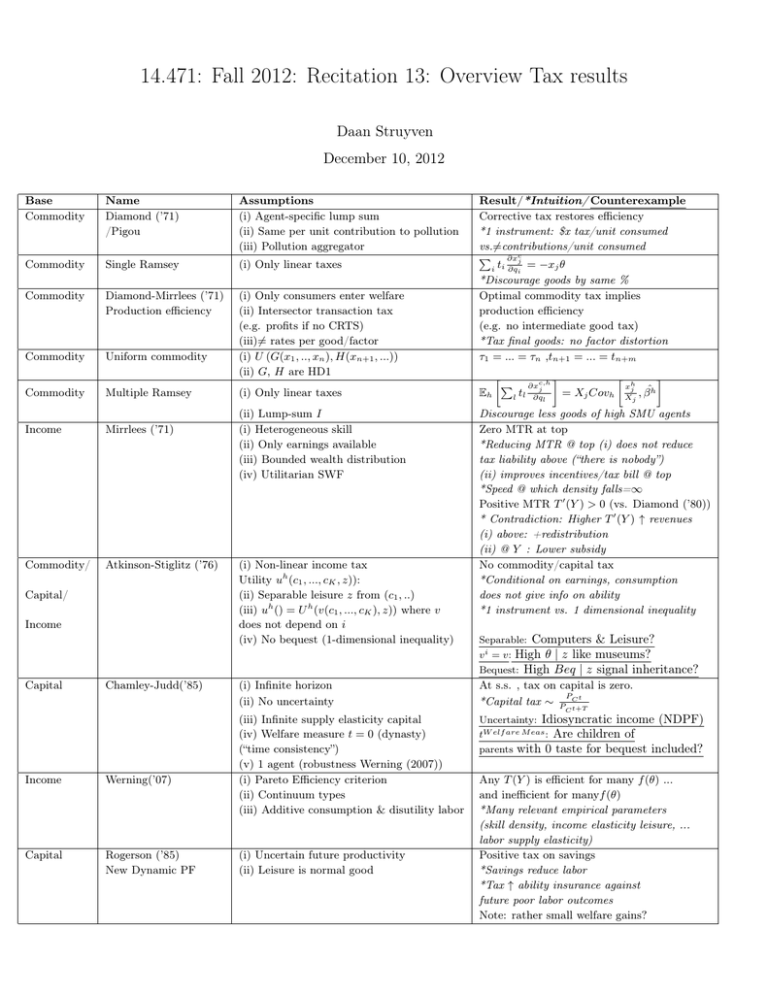14.471: Fall 2012: Recitation 13: Overview Tax... Daan Struyven December 10, 2012
advertisement

14.471: Fall 2012: Recitation 13: Overview Tax results Daan Struyven December 10, 2012 Base Commodity Name Diamond (’71) /Pigou Assumptions (i) Agent-specific lump sum (ii) Same per unit contribution to pollution (iii) Pollution aggregator Commodity Single Ramsey (i) Only linear taxes Commodity Diamond-Mirrlees (’71) Production efficiency Commodity Uniform commodity (i) Only consumers enter welfare (ii) Intersector transaction tax (e.g. profits if no CRTS) (iii)�= rates per good/factor (i) U (G(x1 , .., xn ), H(xn+1 , ...)) (ii) G, H are HD1 Commodity Multiple Ramsey Income Mirrlees (’71) Commodity/ Atkinson-Stiglitz (’76) Capital/ Income Capital Chamley-Judd(’85) Income Werning(’07) Capital Rogerson (’85) New Dynamic PF Result/*Intuition/ Counterexample Corrective tax restores efficiency *1 instrument: $x tax/unit consumed vs.�=contributions/unit consumed � ∂xcj i ti ∂qi = −xj θ *Discourage goods by same % Optimal commodity tax implies production efficiency (e.g. no intermediate good tax) *Tax final goods: no factor distortion τ1 = ... = τn ,tn+1 = ... = tn+m � � c,h ∂xj � � xh j Xj , βˆh � (i) Only linear taxes Eh (ii) Lump-sum I (i) Heterogeneous skill (ii) Only earnings available (iii) Bounded wealth distribution (iv) Utilitarian SWF Discourage less goods of high SMU agents Zero MTR at top *Reducing MTR @ top (i) does not reduce tax liability above (“there is nobody”) (ii) improves incentives/tax bill @ top *Speed @ which density falls=∞ Positive MTR T � (Y ) > 0 (vs. Diamond (’80)) * Contradiction: Higher T � (Y ) ↑ revenues (i) above: +redistribution (ii) @ Y : Lower subsidy No commodity/capital tax *Conditional on earnings, consumption does not give info on ability *1 instrument vs. 1 dimensional inequality (i) Non-linear income tax Utility uh (c1 , ..., cK , z)): (ii) Separable leisure z from (c1 , ..) (iii) uh () = U h (v(c1 , ..., cK ), z)) where v does not depend on i (iv) No bequest (1-dimensional inequality) (i) Infinite horizon (ii) No uncertainty (iii) Infinite supply elasticity capital (iv) Welfare measure t = 0 (dynasty) (“time consistency”) (v) 1 agent (robustness Werning (2007)) (i) Pareto Efficiency criterion (ii) Continuum types (iii) Additive consumption & disutility labor (i) Uncertain future productivity (ii) Leisure is normal good l tl ∂ql = Xj Covh Separable: Computers v i = v: High θ | z like Bequest: High Beq | z & Leisure? museums? signal inheritance? At s.s. , tax on capital is zero. P t *Capital tax ∼ P C t+T C Uncertainty: Idiosyncratic income (NDPF) tW elf are M eas : Are children of parents with 0 taste for bequest included? Any T (Y ) is efficient for many f (θ) ... and inefficient for manyf (θ) *Many relevant empirical parameters (skill density, income elasticity leisure, ... labor supply elasticity) Positive tax on savings *Savings reduce labor *Tax ↑ ability insurance against future poor labor outcomes Note: rather small welfare gains? MIT OpenCourseWare http://ocw.mit.edu 14.471 Public Economics I Fall 2012 For information about citing these materials or our Terms of Use, visit: http://ocw.mit.edu/terms.



